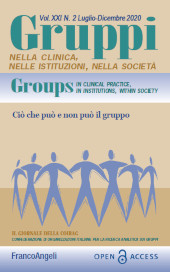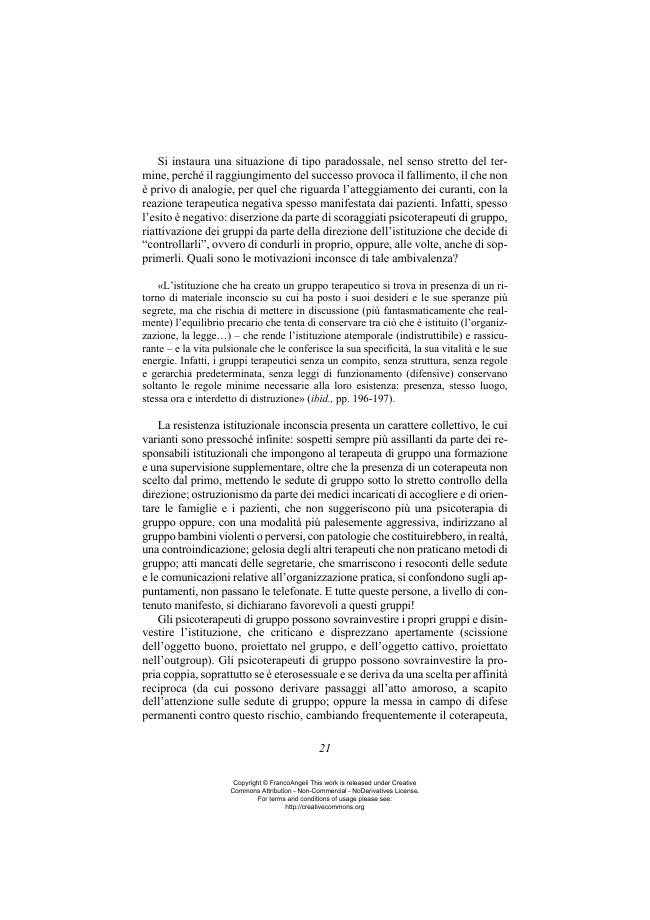Ciò che può e non può il gruppo
15-27 p.
Presentiamo la traduzione di un testo di Anzieu del 1984, pubblicato nel libro di Kaës Le travail de l'inconscient. In questo testo Anzieu tocca molti aspetti della psicoanalisi di gruppo del suo tempo e ciò permette di cogliere le evoluzioni teoriche e tecniche di questa disciplina. Il saggio si apre con una breve introduzione di Kaës, che evidenzia come il metodo definisce in negativo ciò che non può conoscere, riconoscere e quindi trasformare: proprio questa è la chiave di lettura per approcciarsi e comprendere l'intero scritto. Anzieu apre il testo prendendo in esame l'interazione tra i partecipanti del gruppo, il conduttore e l'osservatore: in base al livello evolutivo il gruppo può reagire con vissuti persecutori o depressivi. I terapeuti devono far attenzione a non idealizzare il gruppo come oggetto totale onnipotente o parziale feticistico, e a non cadere quindi nell'illusione che il gruppo può tutto.
L'autore prosegue parlando di diverse tecniche di conduzione di gruppo e delineando possibili scenari interattivi, spesso persecutori e conflittuali, che i gruppi stessi e i loro conduttori mettono inconsciamente in atto con e/o verso le istituzioni in cui sono inseriti. Le istituzioni, a loro volta, posso determinare e condizionare l'esistenza stessa dei gruppi e dei loro destini. Per l'autore diventa fondamentale la creazione temporanea di uno spazio transizionale in cui costruire un apparato psichico gruppale, intermedio tra quello individuale e quello istituzionale, che renda possibile la simbolizzazione, la catarsi e la perlaborazione dei conflitti vissuti tra terapeutagruppoistituzione. [Testo dell'editore].
We present a translation of a text by Anzieu from 1984, published in Kaës' book Le travail de l'inconscient. In this text, Anzieu touches on many aspects of the group psychoanalysis of his time and this allows us to grasp the theoretical and technical evolutions of this discipline. The essay opens with a brief introduction by Kaës, who points out how the method defines in a negative way what it cannot know, recognise and therefore transform: this is the key to approach and understand the whole text. Anzieu opens the text by examining the interaction between the group participants, the conductor and the observer: depending on the developmental level, the group may react with persecutory or depressive experiences. Therapists must be careful not to idealise the group as a total omnipotent or partial fetishistic object, and thus not to fall into the illusion that the group can do everything.
The author goes on to discuss different techniques of group leadership and outlines possible interactive scenarios, often persecutory and conflictual, that groups themselves and their leaders unconsciously enact with and/or towards the institutions in which they are embedded. The institutions, in turn, can determine and condition the very existence of the groups and their destinies. For the author, the temporary creation of a transitional space in which to build a group psychic apparatus, intermediate between the individual and the institutional one, which makes possible the symbolisation, catharsis and perlaboration of the conflicts experienced between therapistgroupinstitution, becomes fundamental. [Publisher's text].
-
Articoli dello stesso fascicolo (disponibili singolarmente)
-
Informazioni
Codice DOI: 10.3280/gruoa2-2020oa12578
ISSN: 1972-4837
MATERIE
PAROLE CHIAVE
- Osservazione, Illusione gruppale, Apparato psichico gruppale, Istituzione, Analisi transizionale, Perlaborazione
- Observation, Group illusion, Group psychic apparatus, Institution, Transitional analysis, Perlaboration



